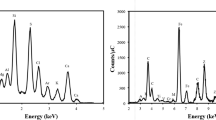Abstract
There are only a few methods of dosimetry which can estimate the contribution of different particles to onboard spacecraft and/or aircraft exposure. This contribution describes an attempt to estimate the contribution of different components to the exposure level using MDU-Liulin energy deposition spectrometer and thermoluminescent detectors (TLD’s), in combination with a spectrometer of linear energy transfer (LET) based on track etch detectors. This equipment was exposed onboard: the International Space Station for a long period and two shorter shuttle missions and a commercial subsonic aircraft for several long-term monitoring periods from 2001 to 2006. The data obtained are analyzed from several points of view and the obtained results are presented, analyzed, and discussed.
Similar content being viewed by others

References
Ts. Dachev, F. Spurný, G. Reitz, et al., “Simultaneous Investigation of Galactic Cosmic Rays on Aircraft and on International Space Station,” Adv. Space Res. 36a,1665–1670 (2005).
F. Spurn and Ts. Datchev, “Long-Term Monitoring on the Onboard Aircraft Crew Exposure Level with Si-Diode Based Spectrometer,” Adv. Space Research. 32, 53–58 (2003).
F. Spurn and Ts. Datchev, “Aircrew Exposure Assessment by Means of a Si-Diode Spectrometer,” Radioact. Environ. 7, 871–875 (2005).
A. Mitaroff and M. Silari, “The CERN-EU High-Energy Reference Field (CERF) Facility for Dosimetry at Commercial Flight Altitudes and in Space,” Radiat. Prot. Dosim. 102, 7–22 (2002).
J.-F. Bottollier-Depois et al., “Exposure of Aircraft Crew to Cosmic Radiation: On-Board Intercomparison of Various Dosimeters,” Radiat. Prot. Dosim. 110(1–4), 411–415 (2004).
Y. Yamashita, N. Nada, H. Onishi, and S. Kitamura, “Preparation and Properties of New CaSO4: Dy [Tm] Thermoluminescent Detectors,” Health Phys. 21, 295–299 (1971).
S. M. Levi, M. Radicheva, and M. Gelev, “Synthesis and Factors Having Influence on Thermoluminescent Properties of CaSO4: Dy [Tm] Luminophor,” Yad. Energ. 20, 57–62 (1983).
F. Spurný, M. Gelev, Luong Dang Thanh, et al., “Response of Polyethylene Embedded TLD’s to Neutrons of Some Polyenergetic Sources,” Radiat. Prot. Dosim. 23, 41–46 (1988).
F. Spurný, “Response of Thermoluminescent Detectors to High-Energy Charged Particles and to Neutrons,” Radiat. Measur. 38, 407–412 (2004).
N. S. Akselrod, V. S. Kortov, D. Y. Kravetsky, and V. I. Gottlib, “Highly Sensitive Thermoluminescent Anion-Defect α-Al2O3: C Single Crystal Detectors,” Radiat. Prot. Dosim. 33, 119–122 (1990).
F. Spurný and I. Votočková, “Response of TLD’s to Protons and α-Particles with Energies below 10 MeV,” Nucl. Energy Safety 1(39), 176–180 (1993).
F. Spurný, J. Bednár, L. Johansson, and A. Sätherberg, “A LET Spectra of Secondary Particles in CR 39 Track-Etch Detectors,” Radiat. Measur. 26, 646–649 (1996).
F. Spurný, J.-F. Bottollier-Depois, and B. Vlček, “Spectrometry of the LET with Track Etched Detectors-Correlation with Proportional Counter Measured Spectra,” Radiat. Measur. 34, 193–198 (2001).
I. Jadrníčková, “Spectrometry of Linear Energy Transfer and Its Use in Radiotherapy and Radiation Protection in High-Energy Particle Fields,” PhD Thesis (Prague, Sept., 2006).
I. Jadrníčková, This Journal.
“ICRP 1990 Recommendations of the International Commission on Radiological Protection,” ICRP Publ. 60, Ann. ICRP 21(1–3), (1991).
D. T. Bartlett and P. Goldhagen, private communication (2005).
K. O’Brien, W. Friedberg, H. H. Sauer, and D. F. Smart, “Atmospheric Cosmic Rays and Solar Energetic Particles at Aircraft Altitudes,” Environ. Intern. 22(Suppl. 1), 9–44 (1996).
H. Schraube, G. Leuthold, W. Heinrich, et al., “EPCARD-European Package for the Calculation of Aviation Route Doses,” Users Manual (GSF-Bericht, 2002).
EURADOS WG5 Report, Cosmic Radiation Exposure of Aircraft Crew: Compilation of Measured and Calculated Data, Ed. by L. Lindborg, D. Bartlett, P. Beck, et al., EC-DG TREN (Luxembourg, 2005).
Author information
Authors and Affiliations
Additional information
The text was submitted by the authors in English.
Rights and permissions
About this article
Cite this article
Spurný, F., Ploc, O. & Jadrníčková, I. Spectrometry of linear energy transfer and dosimetry measurements onboard spacecrafts and aircrafts. Phys. Part. Nuclei Lett. 6, 70–77 (2009). https://doi.org/10.1134/S1547477109010117
Published:
Issue Date:
DOI: https://doi.org/10.1134/S1547477109010117



